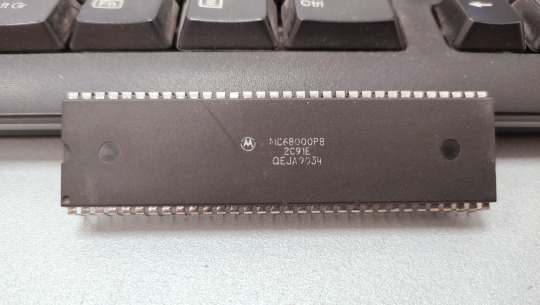#motorola 68000
Text
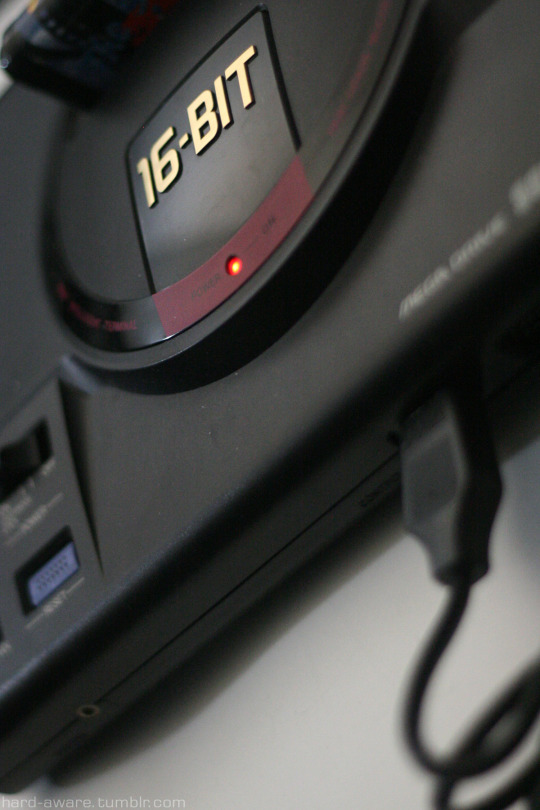
#Mega Drive#Sega Genesis#SEGA#Home video game console#video game#console#1988#Motorola 68000#Zilog Z80#Yamaha YM2612#Sega Meganet#Sega Channel#XBAND
12 notes
·
View notes
Text
Amiga 1000
The Amiga1000 was introduced in the summer of 1985 and was the first machine in the Amiga family. Commodore acquired the technology through the acquisition of the Amiga company, which was originally developed by engineers Jay Miner and Larry Kaplan who had left Atari.
The goal was to develop a gaming platform with graphics and sound capabilities ahead of its time. This goal was achieved, but in the process, they created a complete computer instead of a game console.
The technical side of things went well enough, but financial problems meant they had to look for an investor, and ended up with Commodore.
The Amiga 1000 was a true multimedia computer. The 7MHz Motorola 68000 (PAL/7.09MHz PAL NTSC/7.16MHz) and 256kB of memory were roughly equivalent to those offered by the competition. In contrast, the 8-bit stereo sound and outstanding color graphics were well ahead of its contemporaries. However, neither the PC, Atari ST, nor even the Apple Macintosh had a multitasking operating system (AmigaOS). (although until the advent of faster machines, this was a disadvantage rather than an advantage)
Read more about the story here: Geekometery - Jay Miner & The Amiga Computer
Check these out too if you are interested in retro computing
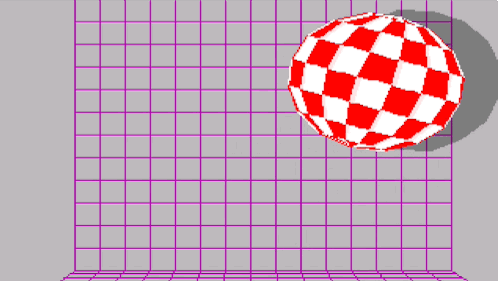
the iconic "Amiga ball" which seemed like a fantastic thing at the time.
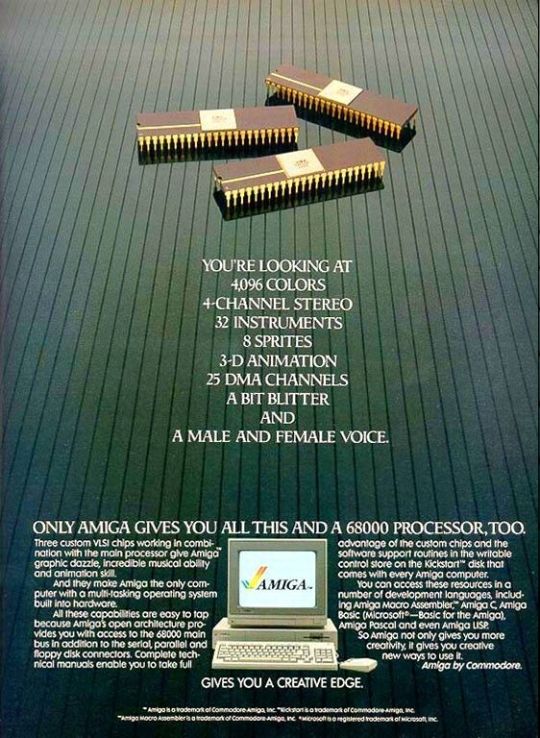
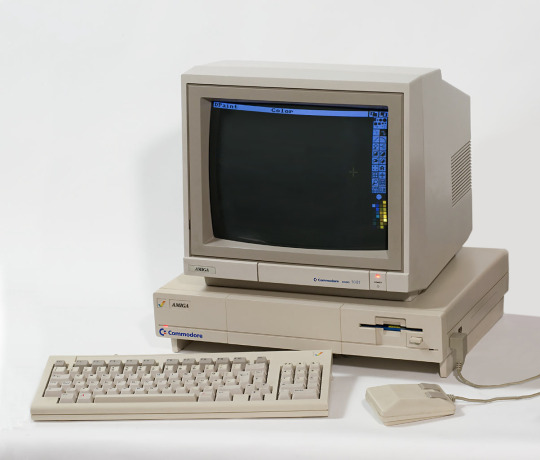

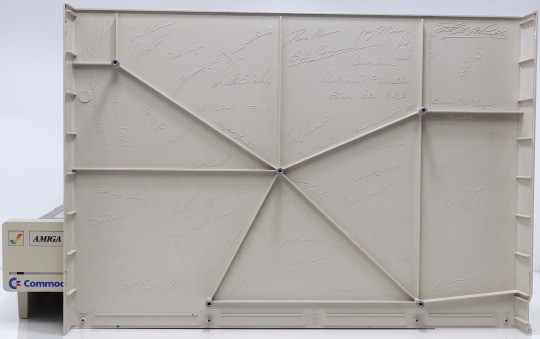
A1000 cover sheet signed by the team members

A1000 in the Stranger Things 4
#amiga1000#amiga#commodore#commodore amiga#retrogaming#retro computing#motorola#Motorola 68000#m68k#jay miner#larry kaplan#source: guialcoholic#1980s
11 notes
·
View notes
Text
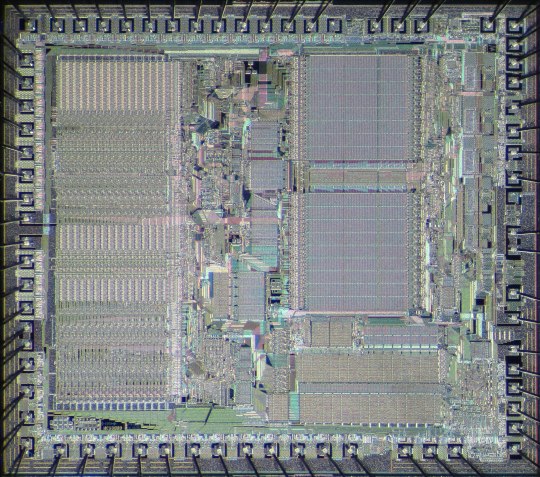
I feel the need to post the partial namesake of this blog, so here is a die shot of the Motorola 68000, taken from Wikipedia, of course.
1 note
·
View note
Link
0 notes
Note
Hello. So what's the deal with computer chips? Let's say, for example, that I wanted to build a brand new Sega Genesis. Ignoring firmware and software, what's stopping me from dissecting their proprietary chips and reverse-engineering them to make new ones? It's just electric connections and such inside, isn't it? If I match the pin ins and outs, shouldn't it be easy? So why don't people do it?
The answer is that people totally used to do this, there's several examples of chips being cloned and used to build compatible third-party hardware, the most famous two examples being famiclones/NESclones and Intel 808X clones.
AMD is now a major processor manufacturer, but they took off in the 70's by reverse-engineering Intel's 8080 processor. Eventually they were called in to officially produce additional 8086 chips under license to meet burgeoning demand for IBM PC's, but that was almost a decade later if I remember correctly.
There were a ton of other 808X clones, like the Soviet-made pin-compatible K1810VM86. Almost anyone with a chip fab was cloning Intel chips back in the 80's, a lot of it was in the grey area of reverse engineering the chips.

Companies kept cloning Intel processors well into the 386 days, but eventually the processors got too complicated to easily clone, and so only companies who licensed designs could make them, slowly reducing the field down to Intel, AMD, and Via, who still exist! Via's CPU division currently works on the Zhaoxin x86_64 processors as part of the ongoing attempts to homebrew a Chinese-only x86 processor.
I wrote about NES clones a while ago, in less detail, so here's that if you want to read it:
Early famiclones worked by essentially reverse-engineering or otherwise cloning the individual chips inside an NES/famicom, and just reconstructing a compatible device from there. Those usually lacked any of the DRM lockout chips built into the original NES, and were often very deeply strange, with integrated clones of official peripherals like the keyboard and mouse simply hardwired directly into the system.
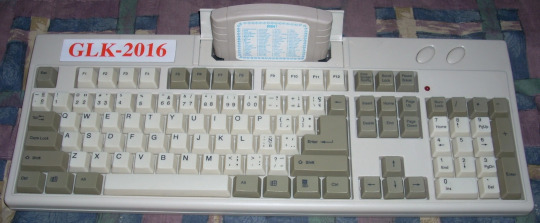
These were sold all over the world, but mostly in developing economies or behind the Iron Curtain where official Nintendo stuff was harder to find. I had a Golden China brand Famiclone growing up, which was a common famiclone brand around South Africa.
Eventually the cost of chip fabbing came down and all those individual chips from the NES were crammed onto one cheap piece of silicon and mass produced for pennies each, the NES-on-a-chip. With this you could turn anything into an NES, and now you could buy a handheld console that ran pirated NES game for twenty dollars in a corner store. In 2002. Lots of edutainment mini-PC's for children were powered by these, although now those are losing out to Linux (and now Android) powered tablets a la Leapfrog.
Nintendo's patents on their hardware designs expired throughout the early 2000's and so now the hardware design was legally above board, even if the pirated games weren't. You can still find companies making systems that rely on these NES chips, and there are still software houses specializing in novel NES games.
Why doesn't this really happen anymore? Well, mostly CPU's and their accoutrements are too complicated. Companies still regularly clone their competitors simpler chips all the time, and I actually don't know if Genesis clones exist, it's only a Motorola 68000k, but absolutely no one is cloning a modern Intel or AMD processor.

The die of a Motorola 68000 (1979)
A classic Intel 8080 is basically the kind of chip you learn about in entry level electrical engineering, a box with logic gates that may be complicated, but pretty straightforwardly fetches things from memory, decodes, executes, and stores. A modern processor is a magic pinball machine that does things backwards and out of order if it'll get you even a little speedup, as Mickens puts it in The Slow Winter:
I think that it used to be fun to be a hardware architect. Anything that you invented would be amazing, and the laws of physics were actively trying to help you succeed. Your friend would say, “I wish that we could predict branches more accurately,” and you’d think, “maybe we can leverage three bits of state per branch to implement a simple saturating counter,” and you’d laugh and declare that such a stupid scheme would never work, but then you’d test it and it would be 94% accurate, and the branches would wake up the next morning and read their newspapers and the headlines would say OUR WORLD HAS BEEN SET ON FIRE. You’d give your buddy a high-five and go celebrate at the bar, and then you’d think, “I wonder if we can make branch predictors even more accurate,” and the next day you’d start XOR’ing the branch’s PC address with a shift register containing the branch’s recent branching history, because in those days, you could XOR anything with anything and get something useful, and you test the new branch predictor, and now you’re up to 96% accuracy, and the branches call you on the phone and say OK, WE GET IT, YOU DO NOT LIKE BRANCHES, but the phone call goes to your voicemail because you’re too busy driving the speed boats and wearing the monocles that you purchased after your promotion at work. You go to work hung-over, and you realize that, during a drunken conference call, you told your boss that your processor has 32 registers when it only has 8, but then you realize THAT YOU CAN TOTALLY LIE ABOUT THE NUMBER OF PHYSICAL REGISTERS, and you invent a crazy hardware mapping scheme from virtual registers to physical ones, and at this point, you start seducing the spouses of the compiler team, because it’s pretty clear that compilers are a thing of the past, and the next generation of processors will run English-level pseudocode directly.

Die shot of a Ryzen 5 2600 core complex (2019)
Nowadays to meet performance parity you can't just be pin-compatible and run at the right frequency, you have to really do a ton of internal logical optimization that is extremely opaque to the reverse engineer. As mentioned, Via is making the Zhaoxin stuff, they are licensed, they have access to all the documentation needed to make an x86_64 processor, and their performance is still barely half of what Intel and AMD can do.
Companies still frequently clone each others simpler chips, charge controllers, sensor filters, etc. but the big stuff is just too complicated.
183 notes
·
View notes
Text
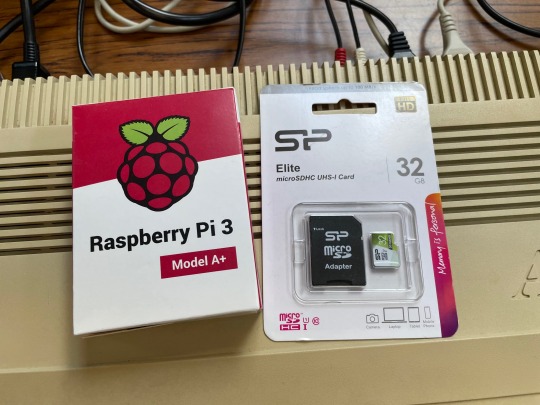
I've been waiting years to get my hands on a Raspberry Pi 3 Model A+ so that I can try the PiStorm project in my Amiga 500
If you're not familiar, it allows for the Motorola 68000 CPU of an Amiga to be replaced with a Raspberry Pi that in turn emulates the original CPU in software.

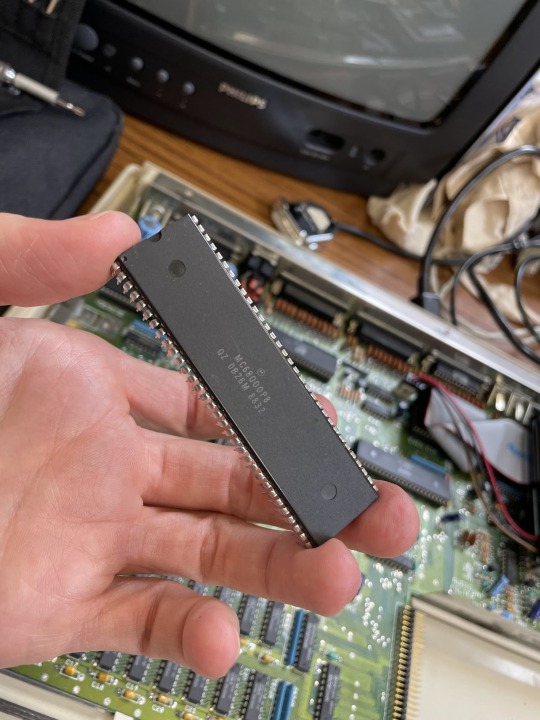
At a basic level this lets you upgrade the performance of the Amiga, as it's possible to run at much faster speeds than the original CPU. Very useful
However that's only the start of the feature set. You can also simulate additional memory, hard drive support, retargetable graphics (to output via the Pi's HDMI port), networking support, upgrading the native Kickstart ROM and more.
Essentially as the CPU socket has access to all the components of the Amiga, it has the capability to override and replace any of these native chips.
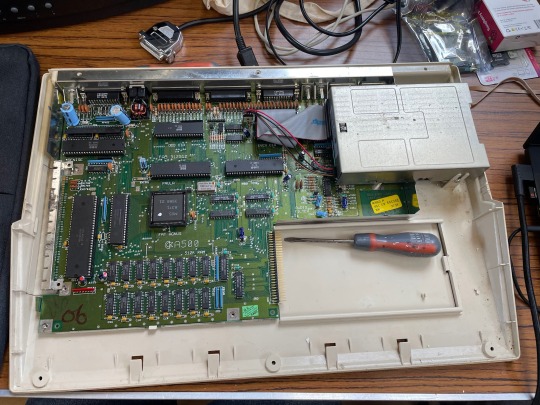
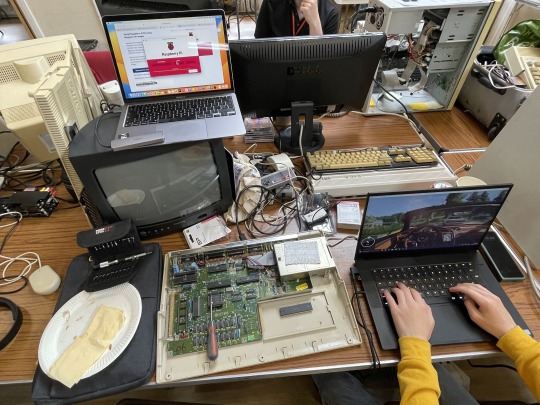
What better excuse and environment to perform the upgrade than the September 2023 SWAG meet up.
After cracking open my A500 for the first time I gently unseated the 68000 from it's socket and prepared to install the PiStorm. It was only then I realised I'd forgotten to bring the vital component, a small board that allows the Pi to connect to the 68000 socket! Oh well, an excuse to play some games instead!
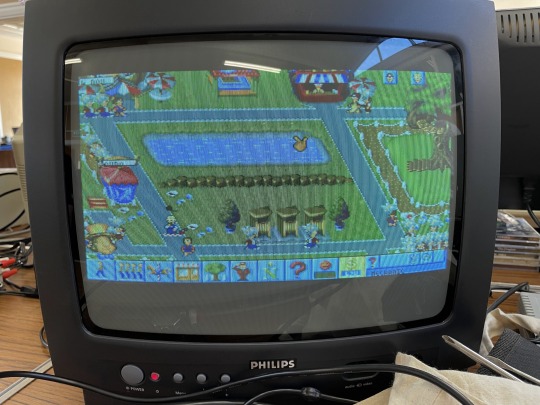
Once I was back in my workshop at home I decided to finish the job. Thankfully with all the correct hardware at hand it was a quick and easy task to get it up and running.

It was certainly quite a nice feeling the first time I started the emulator on the Pi and was rewarded by similar the familiar Kickstart 1.3 appear on the CRT monitor connected to the Amiga.
Seeing old and new hardware work in tandem always gives me a buzz
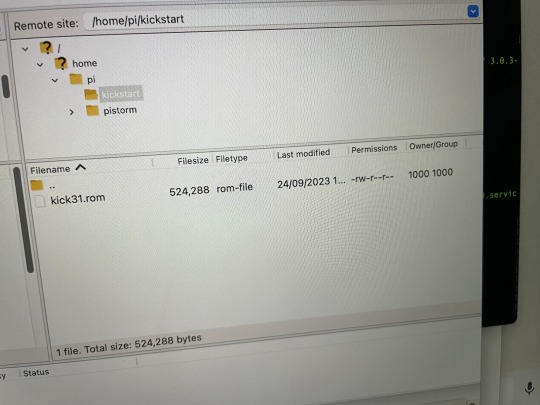

Finally I setup an FTP server on the Pi that enabled me to easily copy across a newer Kickstart version. After restarting the emulator on the Pi suddenly my A500 felt a lot newer.
Next on my list, to setup a virtual hard drive filled with classic games
88 notes
·
View notes
Text
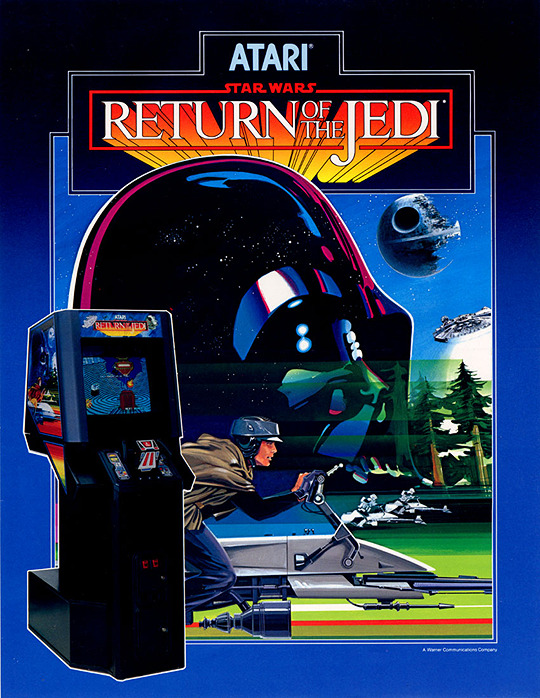
Star Wars: Return of the Jedi
Flyer for Atari's last published arcade game--a 2D diagonal isometric shooter, curiously enough.
After this they were working on a 3D shooter for The Last Starfighter--but its Motorola 68000 processor was expensive at the time, and the movie didn't do as well as had been hoped, so the game was cancelled, and survives only as a prototype. [1]
#star wars#return of the jedi#star wars return of the jedi#atari#arcade game#arcade games#arcade flyer#arcade flyers#video game#video games#1980s#game#games#endor#moon of endor#luke skywalker#darth vader#arcade cabinet#speeder bike#74-z speeder bike#death star#millennium falcon
7 notes
·
View notes
Text


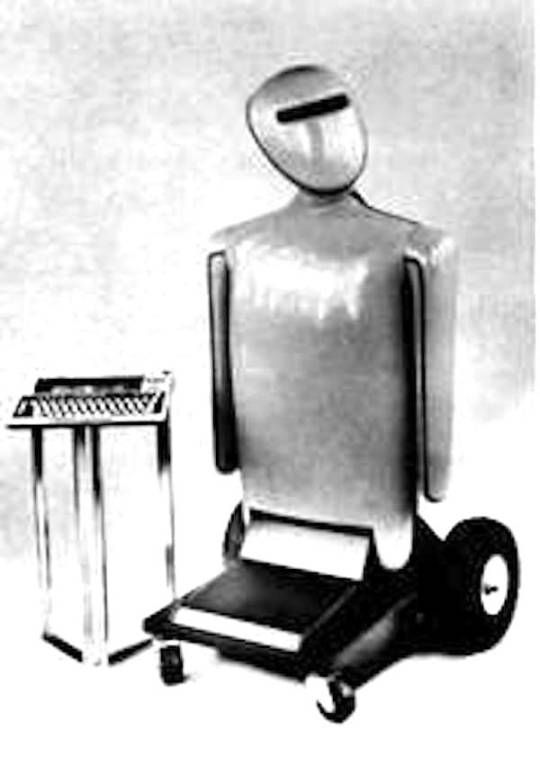
Marvin (Mobile Anthropomorphic Robot VINtage high tech robot) by David Gossman (1983), Iowa Precision Machine Ltd, Milford, Iowa. With its retro, "The Day the Earth Stood Still" styling, Marvin is a 4’2” tall anthropomorphic personal robot. It has 15 degrees-of-freedom in total, including a pair of six-axis arms, a mobile base, and it can also turn its head. Controlled by an on-board Motorola 68000 processor with a standard disk drive, it navigates using ultrasonic ranging. It also has a speech synthesizer with a 500-word vocabulary. “"Marvin was originally designed and developed to be an educational tool, a training aid, primarily at post-secondary institutions, to facilitate the training of individuals in programming robots for industry and for students on the engineering side of the card," he said, Marvin's insides are much like the insides of industrial robots, but he sells for around $6,000 instead of $30,000 to $150,000 as industrial robots do, explained Gossman. That makes robotics courses affordable for post-secondary schools, he said, Marvin contains a computer eight times more powerful than a common personal computer, He can be programmed with the help of a computer terminal that plugs into his back and a computer language the firm developed just for him. Marvin has a large vocabulary, although Gossman admits his speech is sometimes hard to understand the first time it's heard. More understandable speech synthesizers could have been used but they had a limited vocabulary, he explained, Marvin's two arms have six movable joints and can lift objects weighing up to five pounds. He has wheels instead of feet and a sonar system that lets him find his way around objects by bouncing sound off them, Gossman came up with the idea of manufacturing Marvin about two years ago when he saw that schools could use a sophisticated, yet cheap, tool to teach robotics. Gossman said he decided to make Marvin have a human shape only because it "tends to attract attention" and not because there is any real need for him to look human-like, … "I really don't know whether robotics is the wave of the future, Wave of the future may be a bit strong," said Gossman” – by Judy Daubenmler, The Daily Reporter – Sep 20, 1984
32 notes
·
View notes
Text
Extra Thinky Bits

Ever since I built my 68000 computer, I've used a BASIC Mandelbrot rendering program I got from RosettaCode as a test benchmark. On the 6MHz 68000 it took nearly 10 minutes to run. With the 68030 running at 56MHz using a 32-bit data bus with L1 cache enabled, the same BASIC program completed in around 14 seconds.
But we can do better. EhBASIC is written in assembly to use 32-bit single-precision floating point numbers internally, but all of its mathematical routines use the CPU's integer ALU. There are large sections of code that could theoretically be replaced by single instructions for the 68882 floating point math coprocessor (FPU).
Adding the FPU is where I stopped on my original wire-wrapped prototype. I simply never could get it working reliably. I've since learned that I had some logic errors that were probably causing more trouble than my chosen method of prototyping. But this meant it was probably best to start over, and if I'm starting over, a custom PCB with a CPLD to handle logic & timing would be much easier, much more flexible, and much more reliable.
Another tumblr user, Avics1967, had pointed out that logic error to me a while back. It turns out the 68882 FPU is picky about the setup time relationship between the FPU's Chip Select signal and the CPU's Address Strobe signal. Basically, the Chip Select signal can't be transitioning at the same time that the Address Strobe signal is falling, and there's a few nanoseconds on either side of that AS# transition where the CS# signal must be stable. My original design didn't take this into account.
This setup time target ended up being harder to hit than I anticipated. With my little system running at 40MHz, there is just 12.5ns between the CPU asserting the address bus and the CPU asserting its Address Strobe. I need to allow about 3ns for the FPU Chip Select signal to be stable before AS# falls.
I'm using a 10ns CPLD for logic.
My first draft for the logic also did not meet timing requirements, and with my bus speed and parts on hand it never would. Luckily, the 68882 also supports what Motorola called "Late Chip Select", where the CS# signal could be asserted after AS#. So that's what I ended up doing — I implement a delay synchronous to the CPU clock to assert CS# half a clock after AS#.
I ran into an interesting problem while testing though. I assembled a short program to add 2+3 and store the result in memory where I could check if the result of 5 was stored properly. What I got instead was an endless chain of bus errors. If I hit reset quickly enough I could see the very first error was actually an Address Error, and then came the endless chain of Bus Errors.
This made no sense. The FPU can generate some exceptions, like the Coprocessor Protocol Violation I had gotten with my last prototype. And if there was a problem with my logic, a Bus Error might be thrown if the FPU wasn't detected or didn't respond in time. But an Address Error?
Turns out the FPU wasn't the problem at all. There was a typo — a single missing # — in my monitor which caused the CPU to try to load an odd instruction as a pointer instead of the actual pointer to the exception handler routine. So something was indeed causing an exception, but I couldn't see what the exception actually was because it was immediately followed by an Address Error which also spawned a Bus Error.
Thankfully, my exception table is in RAM, so I was able to patch it live before running my test program. And the next time I tried testing the FPU? It worked!
I have no idea what was causing the initial exception, but the FPU has been working for me since.
Now it's time to write some more sophisticated programs to really test the FPU, and maybe modify BASIC to use the FPU instead of its built-in arithmetic functions.
37 notes
·
View notes
Photo


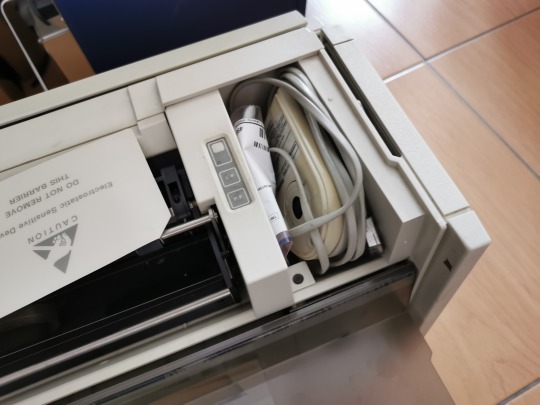


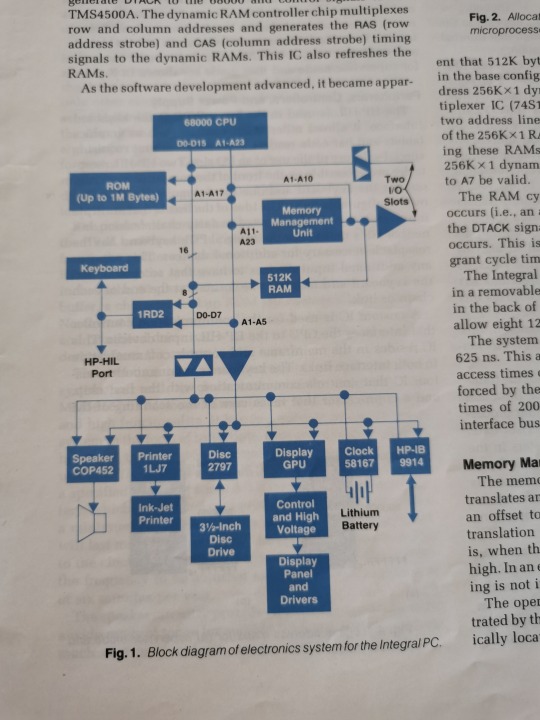

New Item: HP Integral Personal Computer
I am trying to avoid buying any old computer, but a friend of mine and I made an exception in this case and bought this together. Somebody in Prague offered a non-working HP Integral Personal Computer (1985) for $420. It was just 15 minutes of traveling from my friend’s home, so he visited the seller and told him that he would buy it if he could look into it, measure voltages and check for corrosion (either from caps or a leaked battery). The seller agreed. They briefly started the computer, but only horizontal bars were flashing on the screen. Then he disassembled the system, and everything was in pristine condition and all voltages were ok. After reassembling, he just paid and took it home.
When I visited the friend, he showed the computer. I asked him to start it so I could record a video of the error. To our surprise, the machine started directly into its HP-UX 5.0 UNIX system stored in ROM. Maybe the reseating of the internal boards helped it. Who knows. Anyway, we haven’t played with it more. I will first clean it and it is necessary to check capacitors in the power supply, repair the power button and check why the machine does the high-pitch sound when operating – it sounds like a hard drive which is not there.
I love how the machine looks like and it is even smaller than I expected. When carried, it is just as tall as my 1989 Toshiba T3200SX with a 386SX CPU, 3MB of RAM and a VGA gas-plasma display… and it is not much heavier.
HP Integral Personal Computer is based on the Motorola 68000 CPU and has at least 512KB of RAM. In addition to the ROM storage containing the operating system, there is just a single internal floppy drive (720KB 3.5”). More storage devices can be connected using HP-IB though. I always wanted this machine. I even have a HP Journal magazine from 1985 with a very in-depth description of each internal component.
Original article with more/high-res photos here.
91 notes
·
View notes
Photo
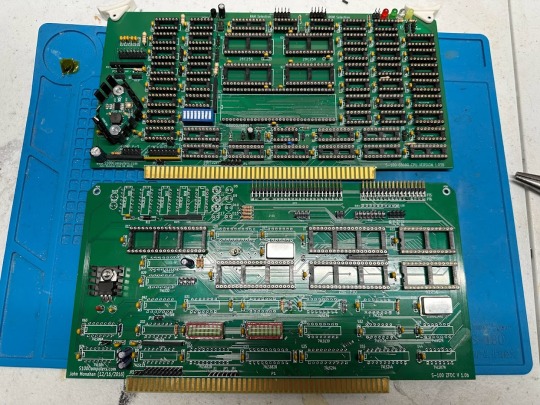
S-100 Boards in progress: The S100computers 68000 CPU board, and ZFDC (Zilog Floppy Diskette Controller).
The 68k CPU board is pretty much a complete Motorola 68000-based system on a single board, along with hardware needed for it to operate in a multi-CPU arrangement. The S-100 standard allows for the presence of multiple CPU boards with wildly different architectures, but only one can be in control of the bus at a time. I had to trim off part of the voltage regulator heatsink to allow it to work with my card cage’s retention brackets.
The ZFDC is a very complex floppy disk drive controller. It pairs a dedicated 6MHz Zilog Z80B processor with a pair of Zilog PIO (Parallel Input/Output) and a Western Digital 2793 disk controller chip. The on-board CPU has access to 32k of onboard ROM and onboard RAM, making it a entire self-contained computer which operates independently of any other processor boards the user has installed.
It’s curious to note that the 6MHz Z80 on the ZFDC actually runs faster than my machine’s main CPU board, the S100computers Z80 Master CPU, which runs at a standard 4MHz. Owing to a fairly simplistic design rooted in choices made while MITS was designing the Altair 8800, the S-100 bus does poorly with speeds significantly over that 4MHz. The ZFDC has onboard RAM/ROM and doesn’t really touch the bus aside from simple one-byte commands, however, which lets us use a higher speed part that can cope with high-demand operations like formatting double-density diskettes.
8 notes
·
View notes
Photo
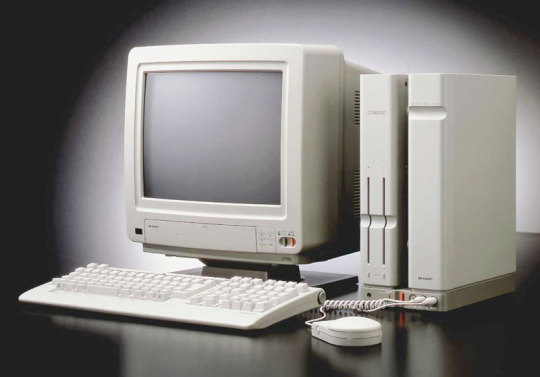
Sharp X68000 series (1987-1993) // The X68000 series of computers were released between 1987 and 1993, and were named after the processor in the base version, the Motorola 68000 chip (although the initial versions were based on a 68000 chip, and later versions were not).
http://museum.ipsj.or.jp/en/computer/personal/0038.html
5 notes
·
View notes
Text

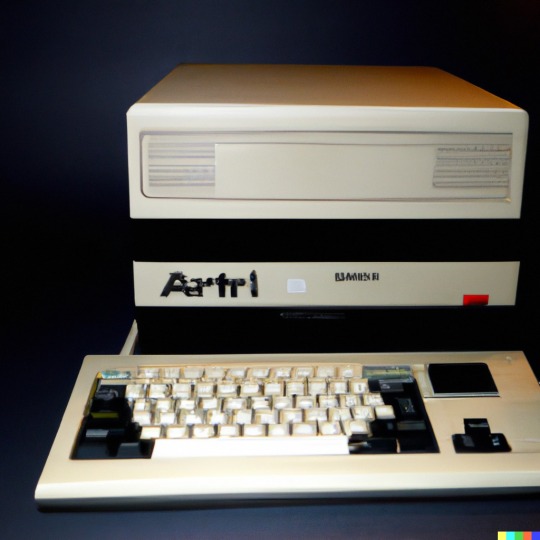


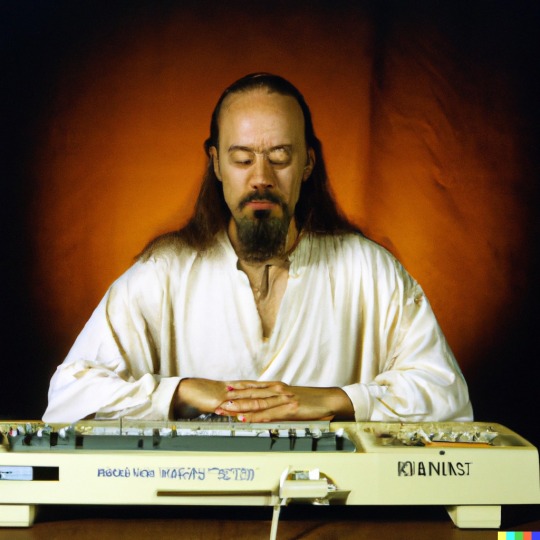
HAVing Fun wiTh DALL-e.
"A GURU meditAtion on a mOtoROLA 68000"
"aN atAri st LoOking Like aN aMiGa 1200"
16 notes
·
View notes
Video
youtube
1987 Commodore AMIGA 500 Computer (Motorola 68000 processor, graphics s...
4 notes
·
View notes
Text
In the early 1990s, while American gamers were enjoying their Super Nintendo and Sega Genesis consoles, a revolutionary gaming system was making waves in Japan: the FM Towns Marty. Developed by Fujitsu, this cutting-edge console never made its way to the United States, leaving American gamers oblivious to the incredible gaming experiences they were missing out on.
The FM Towns computer system was first released by Fujitsu in Japan on February 28, 1989. It was designed as a high-end personal computer with advanced multimedia capabilities, targeting both business and entertainment markets.
[caption id="attachment_168521" align="aligncenter" width="1280"] FM Towns[/caption]
The FM Towns Marty was released by Fujitsu in Japan on February 20, 1993. It was designed as a multimedia console and computer system, aimed at providing high-quality audio and video capabilities alongside its gaming functions.
[caption id="attachment_168520" align="aligncenter" width="2000"] The FM Towns Marty[/caption]
The FM Towns Marty and PC not only influenced the gaming industry through their hardware capabilities but also had a significant impact on game development practices. The consoles' CD-ROM technology allowed for larger storage capacity, enabling developers to create games with more extensive content, higher-quality audio, and full-motion video cutscenes.
Moreover, the FM Towns Marty and PC attracted the attention of prominent game developers and publishers. Companies like LucasArts, Origin Systems, and Sierra On-Line saw the potential in these consoles and released enhanced versions of their popular titles for the platform. This demonstrated the growing interest in CD-ROM-based gaming and set the stage for future consoles that would heavily rely on this technology.
Ahead of Its Time
In many ways, the FM Towns Marty and PC were ahead of their time. They offered features and capabilities that were not common in other gaming systems of the era. For example, the Marty's ability to play audio CDs and the PC's support for high-resolution graphics were groundbreaking features that would later become standard in future consoles.
Additionally, the FM Towns Marty and PC were among the first systems to offer online gaming capabilities. Through the use of a modem, players could connect to online services and engage in multiplayer gaming, a feature that was still in its infancy at the time.
FM Towns Marty Specs
The FM Towns Marty boasted impressive specifications for its time. It featured a 32-bit Intel 80386SX CPU running at 16 MHz, coupled with a 32-bit Motorola 68000 CPU at 10 MHz for sound processing. The console had 2 MB of RAM, expandable to 6 MB, and a CD-ROM drive capable of reading discs at double speed. The Marty's graphics were powered by a custom 32-bit RISC chip, allowing for stunning visuals and smooth gameplay.
FM Towns Marty Games
One of the most remarkable aspects of the FM Towns Marty was its library of games. The console played host to a wide array of titles, ranging from arcade ports to exclusive releases. Some notable games included:
Zak McKracken and the Alien Mindbenders: A graphically enhanced version of the classic LucasArts adventure game.
Loom: Another LucasArts adventure, featuring beautiful graphics and an enchanting soundtrack.
Ultima VI: The False Prophet: The first console port of the legendary RPG series, with improved visuals and sound.
Monkey Island 2: LeChuck's Revenge: The sequel to the beloved point-and-click adventure, with enhanced audio and visuals.
These games, among many others, showcased the FM Towns Marty's capabilities and demonstrated how it pushed the boundaries of console gaming at the time.
The FM Towns PC
In addition to the Marty console, Fujitsu also released the FM Towns PC, a computer system designed for multimedia and gaming. The FM Towns PC featured similar specifications to the Marty, with a 486 CPU, 4 MB of RAM, and a CD-ROM drive. It also had a custom graphics chip and supported resolutions up to 720x480 with 32,768 colors.
The FM Towns PC had its own library of games, including exclusive titles and enhanced versions of popular releases. Some notable games were:
Dungeon Master II: The Legend of Skullkeep: An enhanced version of the dungeon-crawling RPG, with improved graphics and sound.
Rayxanber II: A colorful and fast-paced shooter, showcasing the system's graphical capabilities.
Senken: A strategy game set in feudal Japan, featuring beautiful artwork and an engaging storyline.
These games, along with many others, demonstrated the FM Towns PC's potential as a gaming powerhouse.
The Legacy of the FM Towns Marty and PC
Although the FM Towns Marty and PC never made their way to the United States, they left a lasting impact on the gaming industry. The consoles showcased the potential of CD-ROM technology and paved the way for future systems like the Sega CD and the PlayStation.
Moreover, the FM Towns Marty and PC introduced American gamers to Japanese-style gaming, with their unique genres, art styles, and storytelling techniques. Many of the games that debuted on these systems would later be released in the United States, giving players a taste of what they had missed out on.
In conclusion, the FM Towns Marty and PC were revolutionary gaming systems that never got the recognition they deserved in the United States. With their powerful specifications, impressive libraries of games, and innovative features, these consoles could have changed the face of gaming in America. While we may have missed out on these incredible systems, their legacy lives on, reminding us of the constant evolution and innovation in the world of video games.
Check out the top 10 games on the FM Towns Marty.
10. Turbo Out Run (1993) - This upgraded version of the quintessential arcade racer introduced a turbo button, vehicle upgrades, and police cars to the series, adding depth and excitement to the gameplay. The objective was to race a Ferrari F40 across the United States, moving from one checkpoint to another while avoiding traffic and other hazards. Dynamic weather conditions and road obstacles like puddles, traffic barriers, and oil slicks kept players on their toes. Despite some graphical downgrades compared to the arcade version, such as missing background details and fewer road hazards, the FM Towns port featured an impressive arranged Red Book audio soundtrack that elevated the gaming experience.
9. Pu-Li-Ru-La (1994) - Developed by Taito, this obscure beat 'em up featured a surreal and illogical world filled with bizarre characters, crude digitized graphics, and unpredictable WTF moments in every stage. The game's premise involved two kids setting out to restore balance to the world after the flow of time was disrupted, giving the developers creative freedom to craft an utterly unique experience. From a digitized woman flapping in the wind like a flag to a background consisting of a half-naked sumo wrestler standing next to a mountain, Pu-Li-Ru-La consistently surprised and confused players with its absurd visuals and illogical stage designs.
8. Splatterhouse (1992) - A side-scrolling beat 'em up inspired by classic horror films, Splatterhouse stood out for its horror-based themes, use of gore, and unforgettable atmosphere. Players took control of a character clearly based on Jason Voorhees, punching, kicking, and using weapons like 2x4s, shotguns, and meat cleavers to battle through waves of enemies. The game kept players engaged with its varied enemy encounters, from zombies emerging from the floor to monsters that needed to be taken down with harpoons. The FM Towns version, with its enhanced visuals and audio, is arguably the best version of the game ever released.
7. Puyo Puyo (1994) - This influential puzzle game featured a robust one-player mode, competitive multiplayer, and combo-centric gameplay that rewarded players and punished opponents. In the single-player campaign, players faced off against 12 computer-controlled opponents,
each with their own personalities and playstyles, with the story progressing through cutscenes. The competitive multiplayer mode was where Puyo Puyo truly shined, allowing players to set off chain reactions and clear multiple groups of blobs simultaneously, sending garbage blobs to their opponent's field. The FM Towns version boasted an amazing jazzy soundtrack that surpassed the arcade version.
6. Monkey Island 2: LeChuck's Revenge (1994) - This classic Lucasfilm adventure game, running on the SCUMM engine, featured a witty and humorous storyline, memorable characters, and an amazing soundtrack. The game's point-and-click interface allowed players to interact with the environment and solve puzzles, with multiple difficulty settings catering to different skill levels. While some puzzles could be annoying, they often served as comedic devices, and the game's sense of humor was its strongest asset. The FM Towns version was considered one of the definitive versions, with improved visuals compared to its DOS counterpart.
5. Raiden Densetsu (1991) - A straightforward yet challenging vertically-scrolling shoot 'em up, Raiden Densetsu offered simple but effective visuals, easy-to-track projectiles, and a fantastic soundtrack reminiscent of 1980s action movie montages. Despite its seemingly understated appearance, with normal-looking houses, generic scenery, and modest weaponry, Raiden Densetsu's simplicity made it one of the most playable shooters of its era. The clear distinction between interactive elements and background objects, combined with the game's memorable soundtrack, created an engaging and enjoyable experience for both solo and co-op play.
4. Super Street Fighter II (1994) - The definitive version of Street Fighter II for the FM Towns, offering solid gameplay, 14 difficulty settings, and a unique color customization mode. As the fourth major iteration of the game, Super Street Fighter II featured a diverse roster of 16 characters and was the first game developed on Capcom's CPS-2 arcade board. Despite some graphical downgrades from the arcade version, such as lower resolution, removed parallax scrolling effects, and missing background animations, the FM Towns port provided a faithful gameplay experience. The inclusion of a special six-button controller and an adapter for Capcom's CPS Fighter arcade stick further enhanced the game's appeal. The FM Towns version also featured an arranged soundtrack that was later used in the 3DO port of Super Turbo.
3. Viewpoint (1993) - An isometric shooter with impressive depth, imaginative enemies, and interesting stage gimmicks, Viewpoint captivated players with its unique perspective and surreal imagery. The game's isometric viewpoint created a sense of depth and made the imposing enemies seem even more impressive, from brightly colored insect-like creatures to ships resembling Slinkies. While relatively light on power-ups, the game allowed players to charge their shots and collect various bombs to create walls of fire, blast zones, or homing missiles. The inclusion of levers and gates to break up the action added variety and prevented the game from feeling repetitive. The FM Towns version was the closest to the original Neo Geo release, offering an authentic and challenging experience.
2. Alltynex (1996) - This exclusive vertically-scrolling shooter allowed players to switch between a ship and a mecha, adding an element of strategy not seen in most shooters. The ability to transform into a robot and obliterate bullets with a giant sword was an incredibly satisfying mechanic, providing a fresh take on the genre. While the ship form was weaker, it excelled at long-range attacks with its upgradeable spread shot and secondary homing laser. In contrast, the mecha form was more powerful but required players to get up close and personal with enemies, leaving less time to react to their attacks. Despite its generic setting and storyline, Alltynex's innovative gameplay mechanic made it a standout title on the FM Towns.
1. Tatsujin Ou (1993) - A vertically-scrolling shooter with impressive weapon effects, intelligent enemies, and six large areas guarded by imposing bosses, Tatsujin Ou is probably the best reason to own an FM Towns. As the only home port of the game, the FM Towns version offered players the opportunity to experience the sequel to the famous Tatsujin (known as Truxton outside of Japan) in the comfort of their own homes. The game featured various power-ups to increase speed and firepower, as well as the ability to change the main weapon from a standard canon to a more powerful beam. The bright, persistent lasers and impressive bomb effects, such as skull-shaped explosions, added to the game's visual appeal. What set Tatsujin Ou apart from other shooters was the intelligence of its enemies, which actively swerved to avoid the player's bullets, creating a more engaging and challenging experience.
These eight games represent some of the best experiences available on the FM Towns Marty, highlighting the console's technical prowess, innovative features, and ability to deliver captivating gameplay. While the FM Towns Marty may have never reached American shores, these games demonstrate the incredible potential of this unique gaming system.
0 notes
